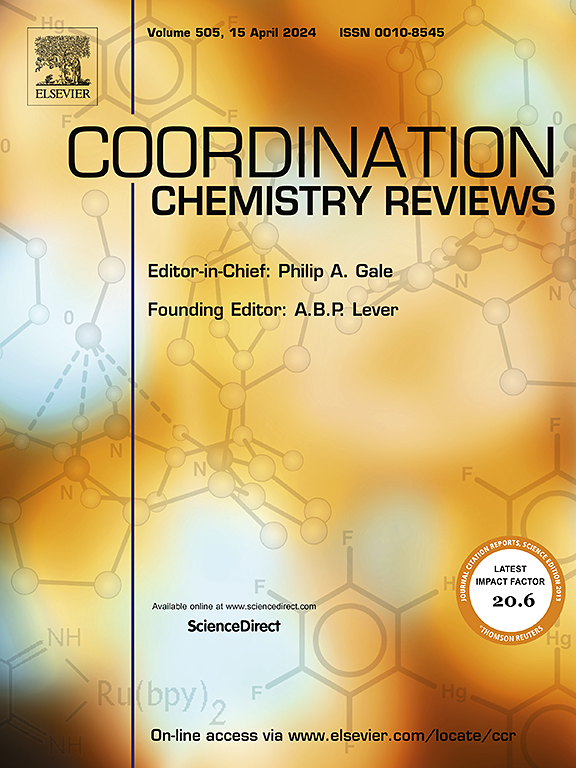Single-atom catalysts: Enzyme-mimicking coordinations, platform designs, and biomedical applications
IF 23.5
1区 化学
Q1 CHEMISTRY, INORGANIC & NUCLEAR
引用次数: 0
Abstract
Recent advancements in nanotechnology have resulted in the appearance of single-atom catalysts (SACs), along with a novel class of materials with the potential to mimic the performance of natural enzymes for a wide range of biological applications. Characterized by atomically dispersed metal sites anchored on appropriate substrates, SACs render unique electronic configurations and maximized metal atom utilization. These properties enhance catalytic activity, selectivity, and stability, which makes SACs more efficient than normal nanocatalysts. These intriguing features allow SACs to address key challenges in biomedicine, including enzyme-like activity for biosensing, targeted therapy, and disease prevention. SACs have shown significant potential in cancer treatment, oxidative stress reduction, antimicrobial therapies, real-time biosensing, and bioimaging, closing the disparity gap between nanozymes and natural enzymes. Furthermore, SAC platforms are versatile, allowing surface modifications and the integration of other materials to improve biocompatibility, catalytic performance, and multi-functionality. This study reviews progress in SAC synthesis, coordination environments, and platform designs, proving their transformative potential in biomedicine. In addition, the main challenges of SACs for clinical use, such as improving substrate selectivity and biocompatibility or ensuring long-term stability, are also considered. When these limitations are addressed, SACs promise to revolutionize therapeutic strategies and allow new solutions for diagnostic innovations, precision medicine and disease management. This work contributes to the growing understanding of SACs and their future applications in catalytic biomedicine.

单原子催化剂:酶模拟配位,平台设计和生物医学应用
纳米技术的最新进展导致了单原子催化剂(SACs)的出现,以及一类具有模仿天然酶性能的新型材料,用于广泛的生物应用。SACs的特点是原子分散的金属位点固定在适当的衬底上,具有独特的电子构型和最大化的金属原子利用率。这些特性增强了催化活性、选择性和稳定性,这使得SACs比普通纳米催化剂更有效。这些有趣的特性使SACs能够解决生物医学中的关键挑战,包括用于生物传感、靶向治疗和疾病预防的酶样活性。SACs在癌症治疗、氧化应激减少、抗菌治疗、实时生物传感和生物成像方面显示出巨大的潜力,缩小了纳米酶与天然酶之间的差距。此外,SAC平台是通用的,允许表面修饰和其他材料的集成,以提高生物相容性,催化性能和多功能。本研究综述了SAC合成、协调环境和平台设计方面的进展,证明了它们在生物医学领域的变革潜力。此外,还考虑了SACs用于临床的主要挑战,例如提高底物选择性和生物相容性或确保长期稳定性。当这些限制得到解决时,SACs有望彻底改变治疗策略,并为诊断创新、精准医学和疾病管理提供新的解决方案。这项工作有助于加深对SACs的理解及其在催化生物医学中的应用。
本文章由计算机程序翻译,如有差异,请以英文原文为准。
求助全文
约1分钟内获得全文
求助全文
来源期刊

Coordination Chemistry Reviews
化学-无机化学与核化学
CiteScore
34.30
自引率
5.30%
发文量
457
审稿时长
54 days
期刊介绍:
Coordination Chemistry Reviews offers rapid publication of review articles on current and significant topics in coordination chemistry, encompassing organometallic, supramolecular, theoretical, and bioinorganic chemistry. It also covers catalysis, materials chemistry, and metal-organic frameworks from a coordination chemistry perspective. Reviews summarize recent developments or discuss specific techniques, welcoming contributions from both established and emerging researchers.
The journal releases special issues on timely subjects, including those featuring contributions from specific regions or conferences. Occasional full-length book articles are also featured. Additionally, special volumes cover annual reviews of main group chemistry, transition metal group chemistry, and organometallic chemistry. These comprehensive reviews are vital resources for those engaged in coordination chemistry, further establishing Coordination Chemistry Reviews as a hub for insightful surveys in inorganic and physical inorganic chemistry.
 求助内容:
求助内容: 应助结果提醒方式:
应助结果提醒方式:


